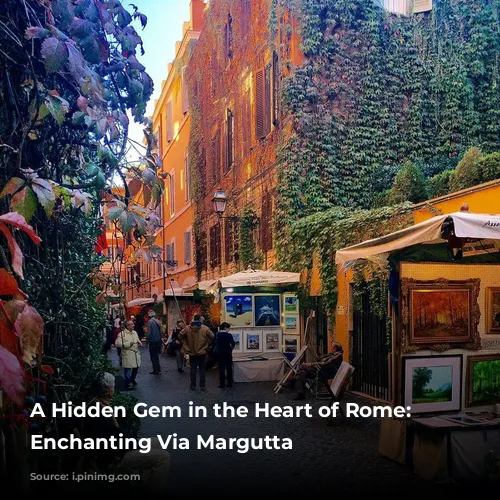“Noble simplicity and quiet grandeur,” – these words, spoken by the renowned art historian Johann Joachim Winkelmann, perfectly capture the essence of Via Margutta, a hidden gem nestled in the heart of Rome. This charming street, tucked away from the bustling crowds of the city center, offers a peaceful retreat for those seeking a glimpse into a different world.
A Street Transformed: From Stables to Studios
Located in the historic Rione Campo Marzio, Via Margutta sits nestled between Piazza del Popolo and Piazza di Spagna. It’s a tranquil escape from the bustling Trident, where you can truly immerse yourself in a different dimension. Ivy and creeping vines adorn the ancient buildings, replacing the grand shops of the city center with art and antique galleries, craft and restoration workshops, and elegant restaurants.
But the history of Via Margutta is a tale of transformation. Once a simple road behind the grand houses of Via del Babuino, it served as a hub for the city’s working class. Stables, depots, and the homes of grooms, masons, marble workers, and coachmen lined the street, a testament to the city’s vibrant daily life.
However, the street’s fate was destined to change. In the Middle Ages, a skilled craftsman opened the first workshop on Via Margutta, bringing with him the art of portraiture, fountain-making, and railing creation. This marked the beginning of a thriving artistic industry that drew talent from all corners of Italy and Europe, particularly from Britain, Flanders, and Germany. Gradually, the humble stables and gardens gave way to beautiful homes, lush gardens, and bustling workshops.
A Street With Many Names and a Rich History
For centuries, the street bore the name Via dei Nari, a tribute to the family who once owned the surrounding land. However, the origins of its current name, Via Margutta, remain shrouded in mystery.
Some attribute the name to “Margutte,” a derogatory nickname given to a local barber known for his large stature, lack of intelligence, and striking ugliness. Others suggest that the barber’s surname was actually “Margut,” as evidenced by 15th-century Roman registry records. There’s even a theory that the name comes from a vulgar contraction of “Marisgutia,” or “Goccia di Mare” (Sea Drop), an ironic name for a foul-smelling brook that flowed down from the Pincii villa, crossed the street, and eventually emptied into the Tiber.
The 19th century brought significant changes to Via Margutta. Under the guidance of Monsignor Francesco Saverio de Merode, a Belgian-born figure, the area was transformed. Sewers were installed, the street was modernized, and the alley was re-imagined as a proper road, becoming a haven for artists and their studios. This transformation breathed new life into Via Margutta, fostering a vibrant and cosmopolitan atmosphere.
A Meeting Place for Art, Culture, and Legends
Over the years, Via Margutta has become a magnet for some of the most influential figures in art, culture, and entertainment. The likes of Pablo Picasso, Renato Guttuso, Giorgio de Chirico, and Novella Parigini have walked its cobbled streets, leaving behind their creative mark. The air has resonated with the music of Wagner, Liszt, Puccini, and Mascagni, and the words of Emile Zola, Gabriele d’Annunzio, Jean-Paul Sartre, Simone de Beauvoir, Elsa Morante, Moravia, and Sibilla Aleramo have filled the charming cafes.
Made famous by the iconic film “Roman Holiday,” starring Audrey Hepburn and Gregory Peck, Via Margutta became a symbol of the “Dolce Vita,” the glamorous period of post-war Italian cinema. Legendary figures like Federico Fellini, Anna Magnani, and Giulietta Masina (Fellini’s wife) called this enchanting street home. Fellini described it perfectly, “Stairs, ladders, hallways that opened between the gardens, then other stairs and ladders. A vertical landscape submerged in greenery, right down to Viale di Trinità dei Monti”.
A Living Legacy of Artistic Expression
Today, the artistic legacy of Via Margutta lives on. Every year, since 1953, the street hosts “100 Pittori,” a unique event that transforms it into an open-air art gallery. Artists from across the globe gather here, injecting their vibrant colors and creative energy into this timeless haven, celebrating its centuries-old artistic tradition.
Via Margutta, a street steeped in history, art, and culture, stands as a testament to the enduring power of creativity. It’s a place where the past and present intertwine, where legends linger, and where the spirit of artistic expression continues to thrive.
